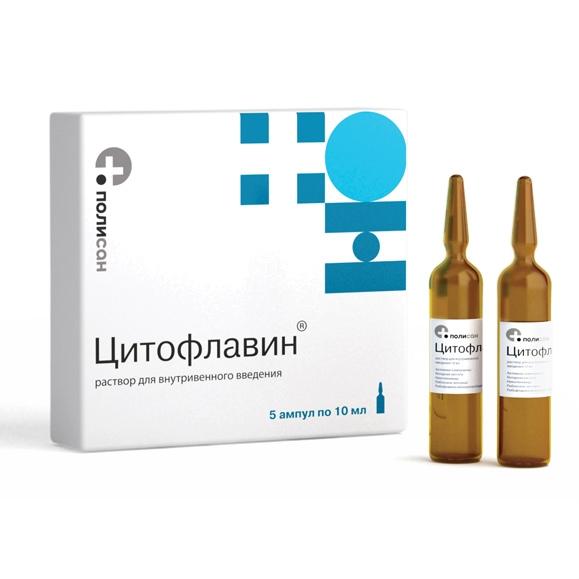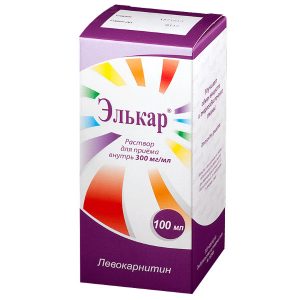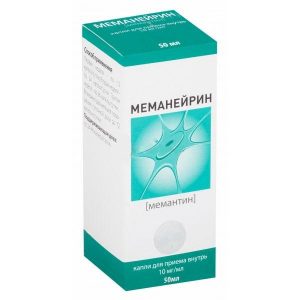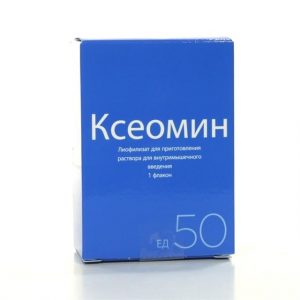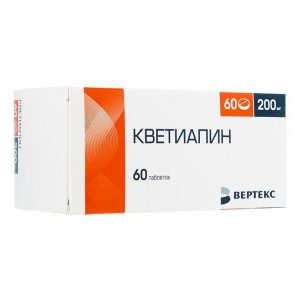Description
Release form
Solution for intravenous administration
Packing
In 1 ampoule of 10 ml of solution. In a blister strip packaging of 5 ampoules. In a pack of cardboard 1 package.
Pharmacological action of
Pharmacodynamics of
Pharmacological effects are due to the complex effect of the components included in the preparation of CYTOFLAVIN ®.
CYTOFLAVIN ® promotes the activation of aerobic metabolism of cells, which leads to an increase in glucose utilization, contributes to an increased level of beta-oxidation of fatty acids and resynthesis of -aminobutyric acid in neurons.
CYTOFLAVIN ® increases the resistance of the membranes of nerve and glial cells to the effects of ischemia, which is reflected in a decrease in the concentration of neurospecific proteins, which characterize the level of destruction of the main structural components of the nervous tissue.
CYTOFLAVIN ® improves coronary and cerebral blood flow, activates metabolic processes in the central nervous system, restores impaired consciousness, promotes regression of neurological symptoms and improvement of cognitive functions of the brain. It has a quick awakening effect in post-anesthetic depression of consciousness.
When using the drug CITOFLAVIN ® in the first 12 hours from the onset of stroke, a favorable course of ischemic and necrotic processes in the affected area is observed (reduction of the focus), restoration of neurological status and reduction of disability in the long-term period.
Pharmacokinetics
During intravenous infusion at a rate of about 2 ml / min (in terms of undiluted CYTOFLAVIN ®), succinic acid and inosine are utilized almost instantly and are not detected in blood plasma.
Succinic acid – the peak concentration is determined within the first minute after administration, with a further rapid decline without cumulation and a return of its level to background values due to metabolization to water and carbon dioxide.
Inosine is metabolized in the liver to form inosine monophosphate, followed by its oxidation to uric acid. In a small amount excreted by the kidneys.
Nicotinamide is rapidly distributed in all tissues, crosses the placenta and into breast milk, is metabolized in the liver to form N-methylnicotinamide, and is excreted by the kidneys. The plasma half-life is about 1.3 hours, the equilibrium distribution volume is about 60 liters, and the total clearance is about 0.6 l / min.
Riboflavin is distributed unevenly: the largest amount in the myocardium, liver, and kidneys. The plasma half-life is about 2 hours, the equilibrium distribution volume is about 40 liters, total clearance – about 0.3 l / min. It crosses the placenta and into breast milk. Communication with plasma proteins – 60%. It is excreted by the kidneys, partly in the form of a metabolite in high doses – mainly unchanged.
Indications
In adults in complex therapy: 1. Acute cerebrovascular accident.
2. The consequences of cerebrovascular diseases (consequences of cerebral infarction, cerebral atherosclerosis).
3. Toxic and hypoxic encephalopathy in acute and chronic poisoning, endotoxemia, post-narcotic depression of consciousness, as well as for the prevention and treatment of hypoxic encephalopathy in cardiac surgery using cardiopulmonary bypass.
In children (including premature babies with a gestational age of 28-36 weeks) in complex therapy in the neonatal period: 1. With cerebral ischemia.
Contraindications
Hypersensitivity, to patients on mechanical ventilation, with a decrease in the partial pressure of oxygen in arterial blood of less than 60 mm Hg. Art., period of breastfeeding.
Precautions – nephrolithiasis, gout, hyperuricemia.
Use during pregnancy and lactation
It is not recommended to take during pregnancy and lactation, due to the lack of clinical data on the effectiveness and safety of the drug during this period
Composition of
1 ml of solution contains:
active substances: succinic acid – 100 mg, nicotinamide – 10 mg, riboxin (inosine) – 20 mg, riboflavin mononucleotide (riboflavin) – 2 mg
excipients: N-methylglucamine (meglu) 165 mg sodium hydroxide 34 mg water for injection
Dosage and administration
In adults: CYTOFLAVIN ® is used only intravenously in a dilution of 100 10 ml of a 5 10% dextrose solution or 0.9% sodium chloride solution.
1. In acute cerebrovascular accident, the drug is administered as early as possible from the onset of the development of the disease in the amount of 10 ml per injection with an interval of 8-12 hours for 10 days. In severe forms of the disease, a single dose is increased to 20 ml.
2. With the consequences of cerebrovascular diseases (consequences of cerebral infarction, cerebral atherosclerosis) the drug is administered in a volume of 10 ml for administration once a day for 10 days.
3. In toxic and hypoxic encephalopathy, the drug is administered in a volume of 10 ml for administration twice a day after 8-12 hours for 5 days. In a coma in a volume of 20 ml for the introduction of a dilution of 200 ml of dextrose solution in a dilution. With post-anesthetic depression, once in the same doses. In the treatment of hypoxic encephalopathy during cardiac surgery using cardiopulmonary bypass, 20 ml of the drug is administered in a dilution of 200 ml of a 5% dextrose solution 3 days before surgery, on the day of surgery, 3 days after surgery.
In children (including premature infants), in the neonatal period with cerebral ischemia, the daily dose of Cytoflavin ® is 2 ml / kg / day. The calculated daily dose of the drug is administered intravenously dropwise (slowly) after dilution in a 5% or 10% dextrose solution (in a ratio of at least 1: 5). The time of the first injection – the first 12 hours after birth, the optimal time to start therapy is the first 2 hours of life. It is recommended to inject the prepared solution with an infusion pump at a speed of 1 to 4 ml / hour, ensuring a uniform flow of the drug into the bloodstream during the day, depending on the estimated daily volume of solutions for basic therapy, the patient s hemodynamics and acid-base status. The average course of treatment is 5 days.
Side effects
With a quick drop-by-drop administration, undesirable reactions may appear that do not require drug withdrawal: hyperemia of the skin of varying severity, a feeling of heat, bitterness and dry mouth, sore throat.
Rare adverse reactions include: short-term pain and discomfort in the epigastric and chest areas, shortness of breath, nausea, headache, dizziness, tingling in the nose, dysosmia, blanching of the skin of varying severity.
Allergic reactions in the form of skin itching are also possible, transient hypoglycemia, hyperuricemia, exacerbation of gout.
In children (including premature infants) in the neonatal period, the development of disorders of the acid-base balance (alkalosis) is possible.
Drug Interaction
Succinic acid, inosine, nicotinamide, compatible with other medicines.
Riboflavin: Decreases the activity of doxycycline, tetracycline, oxytetracycline, erythromycin and lincomycin.
Not compatible with streptomycin.
Chlorpromazine, imipramine, amitriptyline due to the blockade of flavinokinase, impair the inclusion of riboflavin in flavinadenine mononucleotide and flavinadenine dinucleotide and increase its excretion in the urine.
Thyroid hormones accelerate riboflavin metabolism.
Reduces and prevents the side effects of chloramphenicol (violation of hematopoiesis, optic neuritis).
Compatible with hemopoiesis-stimulating drugs, antihypoxants, anabolic steroids.
Overdose
No cases of overdose with cytoflavin have been established to date.
Storage conditions
In a dark place at a temperature of 0 – 25 ° C.
Keep out of the reach of children.
Expiration
2 years.
Active ingredient
Inosine, Nicotinamide, Riboflavin, Succinic acid
Conditions of supply of
Pharmacy Prescription
Dosage form
Dosage form
solution for infusion
Polysan NTFF OOO, Russia
